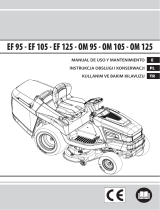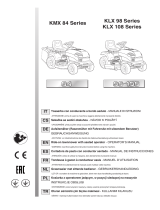
11
en
selves and others from serious injury.
4. Handle fuel with extra care. Fuels are flammable
and vapors are explosive. Use only an approved fuel
container. DO NOT remove fuel cap or add fuel with
engine running. Add fuel outdoors only with engine
stopped and cool. Clean spilled fuel from machine. DO
NOT smoke.
5. Practice operation of machine with BLADES OFF to
learn controls and develop skills.
6. Check the area to be mowed and remove all objects
such as toys, wire, rocks, limbs and other objects that
could cause injury if thrown by blade or interfere with
mowing.
7. Keep people and pets out of mowing area.
Immediately STOP blades, STOP engine, and STOP
machine if anyone enters the area.
8. Check shields, deflectors, switches, blade controls and
other safety devices frequently for proper operation
and location.
9. Make sure all safety decals are clearly legible. Replace
if damaged.
10. Protect yourself when mowing and wear safety glass-
es, a dust mask, long pants and substantial footwear.
11. Know how to STOP blades and engine quickly in
preparation for emergencies.
12. Use extra care when loading or unloading the
machine into a trailer or truck.
13. Check grass catcher components frequently for signs
of wear or deterioration and replace as needed to pre-
vent injury from thrown objects going through weak or
worn spots.
Safe Handling of Gasoline
To avoid personal injury or property damage, use extreme
care in handling gasoline. Gasoline is extremely flam-
mable and the vapors are explosive.
1. Extinguish all cigarettes, cigars, pipes and other sourc-
es of ignition.
2. Use only an approved fuel container.
3. DO NOT remove fuel cap or add fuel with the engine
running. Allow the engine to cool before refueling.
4. DO NOT refuel the machine indoors.
5. DO NOT store the machine or fuel container inside
where there is an open flame, spark or pilot light such
as on a water heater or other appliances.
6. DO NOT fill fuel containers inside a vehicle or on a
truck or trailer bed with a plastic liner. Always place the
containers on the ground away from the vehicle before
filling.
7. Remove gas-powered equipment from the vehicle or
trailer and refuel it on the ground. If this is not pos-
sible, then refuel equipment using a portable container,
rather than a gasoline dispenser nozzle.
8. DO NOT start gas powered equipment in enclosed
vehicles or trailers.
9. Keep the nozzle in contact with the rim of the fuel tank
or container opening at all times until fueling is com-
plete. DO NOT use a nozzle lock-open device
10. If fuel is spilled on clothing, change clothing immedi-
ately.
11. Never overfill a fuel tank. Replace fuel cap and tighten
securely.
Operation
1. Mount and dismount machine from left side. Keep
clear of discharge opening at all times.
2. Start engine from operator’s seat, if possible. Make
sure blades are OFF and parking brake is set.
3. DO NOT leave machine with engine running. STOP
engine, STOP blades, SET brake, and remove key
before leaving operators position for any reason.
4. DO NOT operate machine unless properly seated with
feet on feet rests or pedal(s).
5. STOP BLADES and ENGINE and make sure blades
have stopped before removing grass catcher or
unclogging mower to prevent loss of fingers or hand.
6. Blades must be OFF except when cutting grass. Set
blades in highest position when mowing over rough
ground.
7. Keep hands and feet away from rotating blades
underneath deck. DO NOT place foot on ground while
BLADES are ON or machine is in motion.
8. DO NOT operate machine without entire grass catcher
or guards in place and working. DO NOT point dis-
charge at people, passing cars, windows or doors.
9. Slow down before turning.
10. Watch out for traffic when near or crossing roadways.
11. STOP engine immediately after striking an obstruc-
tion. Inspect machine and repair damage before
resuming operation.
12. Operate machine only in daylight or with good artificial
light.
13. Move joystick (if equipped) SLOWLY to maintain con-
trol during speed and directional changes.
14. Exercise CAUTION when pulling loads. Limit loads to
those you can safely control and attach loads to hitch
plate as specified with attachment instructions.
15. On slopes, the weight of the towed equipment may
cause loss of traction and loss of control. When towing,
travel slowly and allow extra distance to stop.
16. DO NOT operate engine in enclosed areas. Engine
exhaust gases contain carbon monoxide, a deadly
poison.
17. DO NOT discharge material against a wall or obstruc-
tion. Material may ricochet back towards the operator.
18. Only use accessories approved by the manufacturer.
See manufacturer’s instructions for proper operation
and installation of accessories.
Towing
1. Tow only with a machine that has a hitch designed for
towing. DO NOT attach towed equipment except at the
hitch point.
2. Follow the manufacturer’s recommendation for weight
limits for towed equipment and towing on slopes.
3. DO NOT allow children or others on towed equipment.
4. On slopes, the weight of the towed equipment may
cause loss of traction and loss of control.
5. Travel slowly and allow extra distance to stop.





















